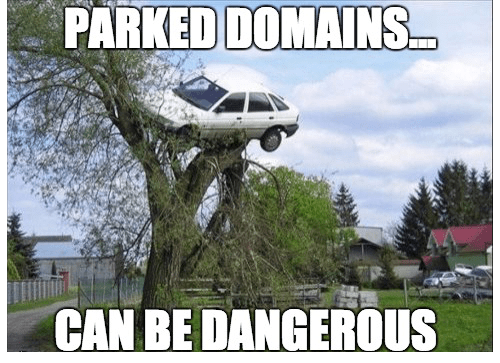
Authored by Patrick Ciavolella, Head, Malware Desk and Analytics, The Media Trust
Enterprise digital ecosystems are ripe for compromise via long-forgotten domains.
In a span of just 30 days, Equifax morphed from a reputable credit bureau to the latest victim of cybercrime. Sadly, Equifax is just one in a slew of recent website compromises. In fact, the past 12 months bore witness to the malicious use of consumer-facing websites belonging to embassies, national banks, popular brands, premium digital publications, and government organizations. Comparing these incidents with The Media Trust’s historic malware attack data reveals an uncanny commonality – parked domains.
Parked domains are pests

Yes, parked domains are a security problem. Let’s take the real-world example of pantry moths as an analogy. Imagine hoarding supplies in your kitchen pantry due to forecasts like historical storms, end of the world, etc. Alas, the event turns out to be not so epic and life moves on unaffected. Except now, you have a cartload of forgotten excess supplies sitting in your pantry, attracting pantry moths, their larvae (gross), and other pests. Translate this to the digital world: companies buy domains for various purposes such as marketing campaigns, testing advertising code, domain squatting prevention, or holding for future use. Unfortunately, life happens; companies do not renew domain ownership, forget to manage them, campaigns end or the company may go out of business. This leaves these domains ripe for compromise, as it’s the perfect opportunity for a bad actor to either buy a legitimate-looking link or stealthily infect it to load malicious code.
“We detect parked domains in more than 10% of web-based incidents and have recorded a steady increase in parked domains in the consumer internet,” stated Patrick Ciavolella, Head Malware Desk and Analytics, The Media Trust. “Saying parked domains are a cause for concern, is an understatement. Malicious parked domains in a large corporation’s digital ecosystem can not only damage an enterprise’s reputation but can inflict widespread harm on consumers.”
By putting Equifax’s second website compromise under the scanner, we can better understand how parked domains are exploited by bad actors.
Equifax Case File
The user experience: When users visited certain credit reporting service page(s) on Equifax’s website, they were automatically redirected to a malicious domain or page. This landing page falsely alerted users to an outdated program (Adobe Flash) and prompted a download of an update, which when clicked, would eventually deliver a malicious exploit kit to user devices. Sounds like a typical and simple website-level malware attack, but what happened behind the screens points to an interesting revelation about parked domains.
Behind the screens: After entering the credit report discounts assistance page, there were at least five rapid auto-redirects (no user interaction required) that delivered users to the malicious domain (Centerbluray.info), which hosted the Fake Flash Update alert. This fake online asset appeared legitimate and even used Adobe’s logo to trick users. Once the user clicked on this fake prompt, malicious toolbars or exploit kits were delivered to the devices.
Culprit: Centerbluray.info was the domain hosting malicious code, but the multiple redirect links that navigated to this malicious page were all parked domains. “Our Malware Desk blacklisted Centerbluray.info well before the Equifax incident and detected it in at least six different web-based malware incidents. In every case, parked domains were used to navigate to the final malicious domain,” added Patrick.
Parked Domains FAQs:

- Wait, so a parked domain via a third-party vendor running code on my website can affect my website?
Yes. Today’s websites and mobile apps are inundated with unmonitored third-party vendors that contribute code (content management systems, video hosting, data management platforms, marketing analytics, social media widgets, and more) to the rendering of digital content. Often, these third-parties will bring fourth and fifth party code into the mix, increasing the probability of a parked domain’s presence in your enterprise digital ecosystem. - Can my own parked domain be compromised?
Yes. The Karmic forces of the internet are strong. Without caution and care, your own parked domains are vulnerable to compromise. Let’s not forget that parked domains are still affiliated with your digital assets. Now would be a good time to ask your teams—marketing, sales, product, operations—about all the domains your company has ever purchased. - Can my current website security solution detect these parked domains?
Sigh, if only! For the most part, website appsec only monitors owned and operated code, which is an increasingly small part of today’s website and mobile app code. Also, most website security solutions do not comprehensively monitor outside the firewall, which is exactly where your users are! Without real-time monitoring of executing code, you would not know if your website has been compromised unless users complain or, even worse, you read about it in the paper. - So what can I do?
Based on the incidents detected in the broader digital ecosystem and managed by The Media Trust, here’s what Patrick recommends:
“When it comes to your own domains, renew them or cancel the ones that are not in use; please cancel through the appropriate channels. Once canceled, the domain code needs to be completely removed from your website and mobile app codebase. Where it makes sense, sign up for an auto-renewing domain. Remember, when it comes to third-party parked domains, the only way to detect and manage them is through continuous, real-time monitoring of code rendering on user devices. - Ok, since you brought up pantry moths – how does one get rid of those annoying pests?
Ah! Clean out your pantry. Get rid of the old dry supplies as they are probably infested by moths and larvae (gross). When you eventually do buy fresh supplies, freeze it first before transferring to storage containers and use the supplies as quickly as you can.




